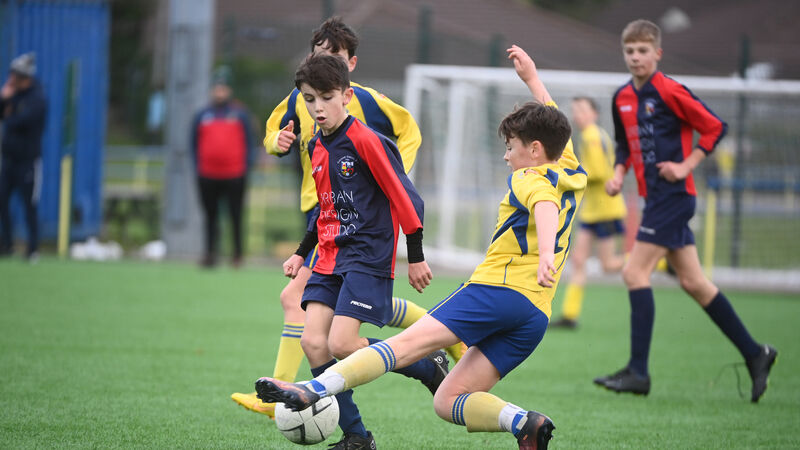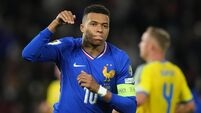Ian Mallon: Why must schoolboys pay big to play elite football?

EXPENSIVE HOBBY: Defender Jack O'Shea wins possession for Douglas Hall as he makes a well-timed tackle on Alex Hennessy, Lakewood Athletic. Pic: Larry Cummins.
The thrill of representing their local sides will be diluted somewhat for their parents, who will pay an average of €350 — or as high as €400 — to the league club in registration costs and other fees.
The competition — comprised of 20 League of Ireland clubs — and a number of additional regional entrants, will take part in what will become the first rung on the FAI’s player pathway programme.
So why, in the search for the very best young footballing talent, are so many children — particularly from financially challenged backgrounds —being priced out of the market?
Why are the most sought-after talents being hit with exorbitant costs to benefit the club, the league, and the FAI, in what should be the sole interest of unearthing the future stars of the game?
Those who cannot pay, or who didn’t present at trials in the first place due to the cost, will continue to play football with their local grassroots club with a way into elite level football ended, and that potential never realised.
A senior league administrator with one of the country’s biggest schoolboy leagues told The Pitch: “If you don’t play in the National League, there will be no way into international football
for that player, you’re cut off.”
If such a scheme existed in South America we would never have witnessed Pele or Diego Maradona or Lionel Messi — but in Ireland it’s acceptable that a burden of cost and a bill of fees is what awaits those who reach the highest standard.
League of Ireland champions Shamrock Rovers will charge under 13 players €310 to play - but there is no fee for U14 and other national league players, Cobh Ramblers have fees of €400 while the newest kids on the block, Klub Kildare charge new recruits €350.
Some feeder clubs — sides with direct pathways into national league clubs — are charging as high as €400, according to our league source, “for the possibility, of an opportunity, to play in the big league”.
Clubs will say that they have to enforce high fees to cover the costs of putting teams on the road, but that’s where the FAI and the club must come up with a financial solution, rather than simply draining the resources of these key assets — the players.
A critic of the fee structure, who spoke under the agreement of anonymity, said he
believed that “in some cases of the breadth of a player’s talent isn’t what counts, it’s the value of their payment”.
For such a financial system to exist, it needs FAI approval and enablement, but the association has a long and uninterrupted history of seeing the development of talent as a cash opportunity.
Just like coaching and the high fee structure for training licences, underage football has become an industry within a sport, where the more you can charge those with the greatest amount to offer, the greater the financial penalty on that individual.
It all comes down to captive audience.
Show me a football coach who wants to learn more about the game and will walk away from a coaching course, even if it comes at a heavy cost.
Or in this case, the U14 schoolboy — or his parents — who has been selected to play in the national league and will want to walk away from such an opportunity.
The establishment of the club’s national league side has created major divisions in Kildare coming as it does in the middle of a winter season in the county’s underage competitions.
To declare an interest — it is also a league in which I volunteer as a coach and co-manager with one of the county’s leading U14 sides.
This has given me the opportunity to analyse the situation from close quarters, speaking to a large body of stakeholders along the way.
In Kildare, the U14 league is reaching its peak, and at its highest level — the Premier Division — many clubs were decimated before Christmas, by players leaving and signing for Klub Kildare.
One club administrator described the situation as “poaching, pure and simple, where if you had it happening between grassroots clubs you’d face serious disciplinary measures from the league”.
A common complaint is the lack of communication or consultation between Klub Kildare and the local clubs, where in most cases the first time achairman will be made aware of such interest is when the boy’s parents ask for a transfer.
Now here’s the rub — one of the chief stakeholders in Klub Kildare is the region’s underage league (KDUL), a unique situation where the league supports the administration of the national league organisation — and even provides it with facilities.
The Pitch has learned that the KDUL also oversees Klub Kildare’s financial reports; indeed, when we contacted the national league club about its finances, the call was answered by an administrator who also administers the local league.
When The Pitch asked the KDUL for a copy of the financial reports, the league refused, and when asked who owned the Klub Kildare organisation, it also turned down the opportunity to clarify the situation.
In Mayo, by comparison, the Mayo Schoolboy/girls Youth League is completely separate from the National League side with no administrative connection.
While all of this might seem quite parochial to some, it once again brings up those age-old question marks about transparency and visibility in Irish football, and the ongoing devastation of grassroots clubs.
When the Pitch asked the FAI about the origins of Klub Kildare, about the selection process for its officers and its links to the KDUL, the association didn’t respond.
There is no doubt that everyone in football who we’ve spoken to wants an elite league, where the very best players play against the best players, week in, week out.
But when the best interests of those elite players, their financial well-being, and a fair and equitable cost system is what’s needed, then that’s something that isn’t up for discussion.
The tournament, with its zany team and individual events, has broken the golden rule of all major sports — if it ain’t broken, don’t fix it.
What is most interesting is the way politics is playing its hand in the broadcast rights issue on this side of the world, particularly where Sky Sports and BT Sports is concerned.
Sky was never going to carry the Saudi-series, given its historic and loyal ties with rivals the US PGA Tour and the DP World Tour.
BT Sport, according to numerous reports is not a runner either, due to its close relationship with Warner Bros., one of the PGA Tour’s leading commercial partners. So that leaves streaming services like Amazon, Disney, and DAZN who must surely be considering carrying the rights in some form?
Well not so, as, according to the Daily Mail, they too have passed on the opportunity, leaving LIV without a major broadcasting home for the season ahead.
As things stand, it looks like a continuation of LIV’s coverage on YouTube will be the order of the day, for now.
An eager assistant told us that the Fianna Fáil TD who represents Meath East would love to talk, but wasn’t available to speak yet, despite popping up on LMFM in recent days.
There he spoke off the same sheet as his predecessors about growing participation, increasing gender quotas, and more of the same.
The big question is what new sports policies Byrne will bring to the table, and while we relayed that we’d love to find that out, the new man in charge disappeared over the horizon.









